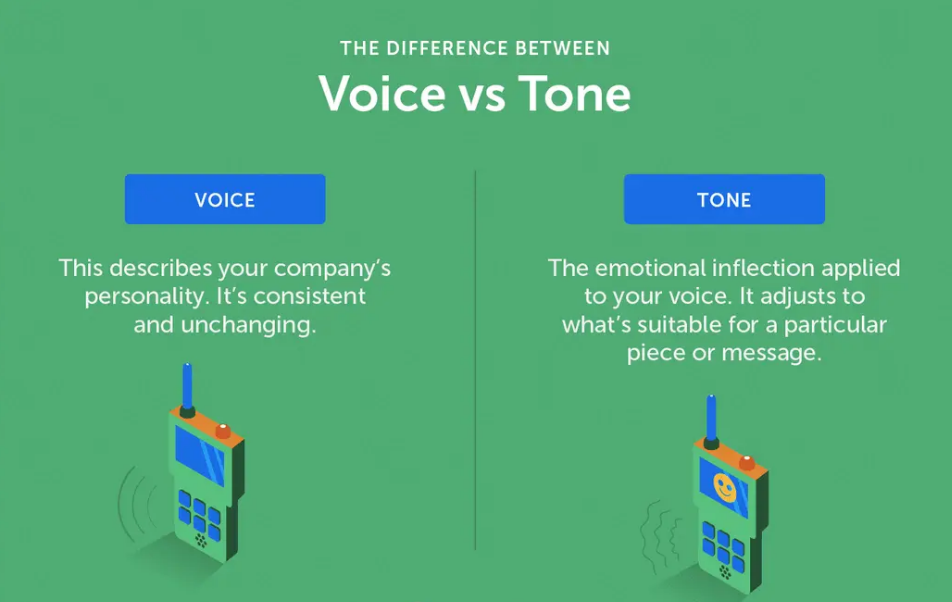Voice and Tone Frameworks: Creating Brand Communication Guidelines

Words matter. The specific language choices your brand makes across touchpoints can either forge lasting connections or create subtle disconnects that gradually erode trust. Yet many organizations struggle with consistent brand communications, particularly as teams expand and channels multiply. This is where voice and tone frameworks become essential—providing strategic guidance while allowing necessary flexibility.
Understanding Voice versus Tone
Though frequently mentioned together, voice and tone serve distinct functions in brand communications. Your brand voice represents your consistent personality—the underlying character that remains recognizable across all communications. Mailchimp describes their voice as “plain-spoken, genuine, and good-humored.” These qualities appear throughout their communications, regardless of context.
Tone, meanwhile, adapts according to situation, audience, and purpose. Even brands with playful voices adopt more serious tones for certain communications. Consider how Slack maintains its helpful, conversational voice while adjusting tone between product announcements (enthusiastic), system outages (responsible), and customer service interactions (empathetic).
Effective frameworks address both elements, providing consistency without rigidity.
The Business Case for Communication Frameworks
Investment in voice and tone frameworks delivers substantial returns across organizations. Research from Lucidpress suggests that consistent brand presentation—including communications—increases revenue by an average of 23%. Beyond revenue, these frameworks offer several organizational benefits.
Frameworks accelerate content creation by eliminating repeated discussions about appropriate communication approaches. Writers spend less time guessing and more time producing aligned content. This becomes particularly valuable during rapid growth phases or when working with external contributors.
They also strengthen brand differentiation in crowded markets. As we’ve explored in our earlier article on brand differentiation, meaningful distinction requires consistency. When communications maintain consistent personality traits, these characteristics gradually become associated with your brand.
Perhaps most importantly, structured approaches to voice and tone build deeper audience connections. When communications consistently align with brand values and audience expectations, each interaction reinforces relationship rather than requiring reintroduction.
Building Your Framework: Essential Components
Effective voice and tone frameworks typically include several core elements. While organizations tailor structure to their needs, most robust frameworks address these fundamental areas.
Begin with voice characteristics—the handful of personality traits that define your brand’s consistent approach. Rather than generic adjectives, develop meaningful descriptors paired with explanatory statements. Instead of simply claiming a “friendly” voice, articulate what friendly means specifically for your brand: “We use everyday language rather than industry jargon, explain complex concepts simply, and acknowledge the human beings reading our words.”
For each voice characteristic, provide comparative examples showing appropriate versus misaligned communications. These concrete demonstrations transform abstract concepts into practical guidance. For example:
On-voice: “We’ve updated our privacy settings to give you more control over your data.”
Off-voice: “Users are hereby notified of modifications to privacy protocols necessitating review of preference configurations.”
Tone guidance requires different structure, typically organized around communication contexts or audience emotional states. Consider developing a matrix showing how voice characteristics manifest differently across distinct scenarios. For customer service, this might address tone variations between handling complaints, answering product questions, and celebrating customer achievements.
Implementation Strategies That Actually Work
Creating frameworks means little without successful implementation. Several approaches increase adoption throughout organizations.
First, involve diverse stakeholders during development. When communicators from different departments contribute to framework creation, they develop ownership that drives implementation. This collaborative approach also ensures the framework addresses varied communication needs across functions.
Second, integrate frameworks directly into content workflows rather than relegating them to reference documents. Consider building templates in your content management system that include voice and tone reminders directly within editing interfaces. Tools like Grammarly Business now offer customizable style guides that can incorporate voice and tone parameters.
Third, reinforce frameworks through regular content reviews. Establish lightweight processes where team members evaluate selected communications against framework parameters. These reviews should function as learning opportunities rather than strict evaluations.
Fourth, evolve frameworks systematically based on performance data and market shifts. Schedule regular reviews of voice and tone guidelines, analyzing whether existing parameters still serve strategic needs. The most sustainable frameworks balance consistency with thoughtful evolution.
Adapting Across Channels While Maintaining Cohesion
Modern brands communicate across increasingly diverse channels, each with distinct constraints and conventions. Effective frameworks address these variations without compromising core voice identity.
Social media platforms each foster particular communication styles. Twitter rewards concision and conversational engagement; LinkedIn expects greater professionalism; TikTok embraces authenticity and creative expression. Voice and tone frameworks should provide channel-specific guidance while maintaining underlying personality consistency.
Similarly, frameworks must address format variations. Video scripts, podcast talking points, customer support responses, and technical documentation each present unique communication challenges. The best frameworks provide format-specific examples demonstrating how core voice characteristics adapt across contexts.
Beyond Words: Extending to Visual and Experience Design
Though primarily focused on verbal communication, sophisticated frameworks increasingly address broader expression. Visual elements—photography style, illustration approach, typography choices—profoundly affect how audiences perceive communications. Frameworks that align verbal and visual expression create powerful synergy.
Similarly, user experience design carries tonal qualities. Interface labels, navigation structures, and interaction patterns all communicate personality. Leading organizations develop integrated frameworks addressing communication across verbal, visual, and experience dimensions.
Conclusion
Voice and tone frameworks transform abstract brand identity into everyday communication practices. When thoughtfully developed and systematically implemented, these frameworks create distinctive, recognizable brand experiences that build lasting audience relationships.
By balancing strategic guidance with practical application, organizations create communications that consistently reinforce brand positioning while adapting appropriately to diverse contexts. The resulting clarity benefits both internal teams and external audiences, converting brand strategy into meaningful interactions that drive business results.





